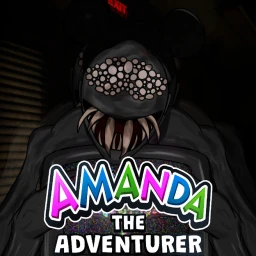At first glance, Amanda the Adventurer looks like a harmless, retro-styled children’s edutainment game reminiscent of early ’90s TV shows like Dora the Explorer. Bright colors, VHS filters, and a peppy talking character invite players into what seems like a nostalgic trip. But just beneath the surface lies a tightly crafted horror experience that uses subversion, narrative puzzles, and psychological tension to disturb and intrigue players.
This review dives into the core design of Amanda the Adventurer, examining how it manipulates player expectations, builds its atmosphere through storytelling, and creates terror using minimal mechanics. We’ll explore its gameplay structure, themes, presentation, and lasting impact in the horror indie scene.
Gameplay: Simplicity Used to Great Effect
Amanda the Adventurer is a short, primarily puzzle-based game that relies on watching old VHS tapes and interacting with segments of a seemingly cheerful kids’ show. While the player character is never seen, the game is set entirely within a dark attic, where you find and play tapes one by one.
Interactive Tapes as the Core Mechanic
Each tape features Amanda and her sidekick Wooly the Sheep, engaging the viewer in basic educational prompts — spelling words, identifying objects, and answering questions. However, your responses begin to have unintended consequences. Answering truthfully or dishonestly leads to different reactions from Amanda, pushing the player to decode what the game really wants.
Puzzle Layering in the Real World
In addition to responding to Amanda’s prompts, players must observe small changes in the attic, including safe locks, code sequences, hidden drawers, and environmental clues that evolve as the game progresses. This dual-layer puzzle format forces players to think laterally and keeps tension high.
Atmosphere: The Power of Contradiction
The core strength of Amanda the Adventurer lies in its ability to contrast tone with content — blending childhood innocence with deeply unsettling behavior.
Visual Design: Retro With Malice
The VHS-style filter is more than an aesthetic choice — it creates distortion, static, and skipping that act as both technical limitations and horror cues. Innocent backdrops like grocery stores and playgrounds are subtly corrupted as Amanda becomes more unhinged.
Sound Design and Voice Acting
The sound is minimal but incredibly effective. Amanda’s chirpy voice starts to sound wrong — a bit too forceful, too scripted — while Wooly’s anxious tone builds dread. Background hums, glitches, and tonal shifts contribute to a slow-burn horror atmosphere that requires no jump scares to work.
Narrative: Subtle, Fragmented, and Disturbing
What makes Amanda the Adventurer so compelling is how it delivers story not through exposition, but implication.
Amanda’s Descent Into Hostility
At first, Amanda is an eager, upbeat host. But as the tapes progress, her mask slips. She begins ignoring player input, becomes hostile to Wooly, and exhibits knowledge of things outside the game’s world. Her constant need for control is deeply unnerving.
Hints of a Tragic Backstory
Clues scattered throughout the attic suggest something darker — references to missing children, experiments, and a company tied to the production of the tapes. The game never states its full lore outright, encouraging the community to decode its mysteries collaboratively.
Themes: Control, Compliance, and Psychological Decay
While short, Amanda the Adventurer is thematically rich, exploring ideas rarely touched by traditional horror games.
Agency vs. Obedience
The game tests your willingness to obey Amanda even when you know it’s wrong. Refuse to go along with her, and you’ll be punished. Comply, and things get worse. This moral trap mirrors psychological studies on authority, cleverly embedded into its gameplay loop.
Childhood Media and Manipulation
By using a parody of educational shows, the game critiques how children’s media can be used to normalize certain behaviors, ideas, or even control mechanisms. Amanda isn’t just scary because she’s angry — she’s scary because she reflects a corrupted form of trust.
Multiple Endings: Moral Choice and Replayability
Amanda the Adventurer features several endings, most of which depend on how much you explore, what responses you give, and how many secrets you uncover.
Outcomes That Feel Earned
The endings range from abrupt and chilling to symbolic and deeply cryptic. Some may show you being absorbed into the tape world. Others leave Amanda alone in the darkness. These outcomes reward both surface-level play and deep digging, giving the game a surprising amount of replay value for its length.
Presentation: Low-Budget But Carefully Designed
This is a small indie title — and it shows. But the developers made wise decisions in where to focus their resources.
Cohesive Aesthetic
Rather than chase high-end graphics, the game leans into its retro VHS look. Everything, from the font to the UI and textures, supports the illusion that you’re watching a corrupted kids’ show.
Efficient Use of Space
The entire game takes place in one attic room and a few tapes. Yet it manages to suggest an entire world and history through implication, environmental storytelling, and tiny details like worn labels, locked boxes, and strange post-it notes.
Community and Theory Crafting
Part of what makes Amanda the Adventurer stand out is how it’s become a launchpad for discussion and speculation.
Fan Theories and Lore Dives
The fanbase has unpacked layers of hidden messages, cyphers, and theories — from Amanda being a possessed AI to Wooly representing a lost child or resistance figure. The game practically begs players to dig deeper, fueling an ongoing metagame.
Streaming and Reactions
Because of its slow reveals and emotionally charged moments, the game has become popular among YouTubers and streamers. Watching reactions is almost as entertaining as playing, helping grow its audience through organic word-of-mouth.
Shortcomings: Not Without Flaws
As strong as it is, Amanda the Adventurer is not without its limitations.
Short Runtime
A full playthrough takes around 45 minutes, maybe longer if you go after multiple endings. While packed with detail, some players may wish for a longer experience or expanded world.
Some Puzzles Are Too Obscure
A few puzzle solutions feel trial-and-error or require external community help to solve. For players who enjoy solo play without guides, this could break immersion.
Lack of Dialogue Branching
Although responses affect the tone, you’re often steered back to the same outcome regardless. There’s limited true divergence in how scenes play out.
Legacy and Potential
Despite its brevity, Amanda the Adventurer has left a strong mark on the indie horror landscape. It demonstrates that a game doesn’t need violence or gore to be disturbing — psychological manipulation and subversion can be just as effective.
Potential for Expansion
With its rich thematic layers and fan interest, the game seems ripe for expansion. More tapes, a deeper backstory, and extended exploration of Amanda’s origins could elevate it into a full-length psychological horror franchise.
Influence on the Genre
By merging the nostalgia of childhood media with existential dread, it’s joined titles like Doki Doki Literature Club and Five Nights at Freddy’s in redefining how horror games engage with familiar formats.
Conclusion
Amanda the Adventurer is a masterclass in subversion and minimalist horror. What starts as a simple VHS-based kids’ game quickly turns into a gripping, unsettling experience that toys with the player’s morality, perception, and emotional instincts. It’s short, eerie, and brilliantly constructed — a haunting reminder of how the things we trust in childhood can become terrifying when twisted just slightly.
It’s a must-play for horror fans, especially those who appreciate games that reward careful observation and don’t rely on cheap scares. Amanda may be an adventurer, but the real journey is the one the player takes — from control to compulsion, curiosity to fear.











